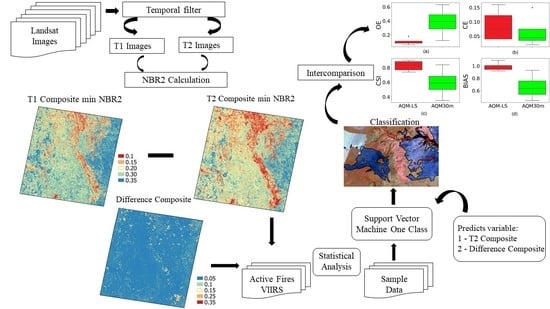Multi-Sensor, Active Fire-Supervised, One-Class Burned Area Mapping in the Brazilian Savanna
Abstract
1. Introduction
2. Materials and Methods
2.1. Study Area
2.2. Datasets
2.2.1. Algorithm Development Dataset
2.2.2. Intercomparison Datasets
2.3. Methods
2.3.1. Algorithm Theoretical Basis
2.3.2. Intercomparison and Validation Approaches
3. Results
3.1. Classification of Burned Area Scars and Accuracy Assessment
3.2. Intercomparison among Automatic and Manual BA Algorithms
3.3. Towards a BA Atlas for the Entire Cerrado
4. Discussion
Author Contributions
Funding
Institutional Review Board Statement
Informed Consent Statement
Data Availability Statement
Acknowledgments
Conflicts of Interest
References
- Coutinho, L.M. Aspectos Ecológicos do Fogo no Cerrado. II—As Queimadas e a Dispersão de Sementes em Algumas Espécies Anemocóricas do Estrato Herbáceo-Subarbustivo. Bol. Botânica 1977, 5, 57. [Google Scholar] [CrossRef]
- Pereira, A.C.; Oliveira, S.L.J.; Pereira, J.M.C.; Turkman, M.A.A. Modelling fire frequency in a Cerrado savanna protected area. PLoS ONE 2014, 9, 102380. [Google Scholar] [CrossRef]
- Silva, P.S.; Nogueira, J.; Rodrigues, J.A.; Santos, F.L.M.; Pereira, J.M.C.; DaCamara, C.C.; Daldegan, G.A.; Pereira, A.A.; Peres, L.F.; Schmidt, I.B.; et al. Putting fire on the map of Brazilian savanna ecoregions. J. Environ. Manag. 2021, 296, 113098. [Google Scholar] [CrossRef]
- Libonati, R.; DaCamara, C.C.; Pereira, J.M.C.; Peres, L.F. Retrieving middle-infrared reflectance for burned area mapping in tropical environments using MODIS. Remote Sens. Environ. 2010, 114, 831–843. [Google Scholar] [CrossRef]
- Libonati, R.; DaCamara, C.C.; Setzer, A.W.; Morelli, F.; Melchiori, A.E. An algorithm for burned area detection in the Brazilian Cerrado using 4 μm MODIS imagery. Remote Sens. 2015, 7, 15782–15803. [Google Scholar] [CrossRef]
- Pereira, A.; Pereira, J.; Libonati, R.; Oom, D.; Setzer, A.; Morelli, F.; Machado-Silva, F.; de Carvalho, L. Burned Area Mapping in the Brazilian Savanna Using a One-Class Support Vector Machine Trained by Active Fires. Remote Sens. 2017, 9, 1161. [Google Scholar] [CrossRef]
- Giglio, L.; Boschetti, L.; Roy, D.P.; Humber, M.L.; Justice, C.O. The Collection 6 MODIS burned area mapping algorithm and product. Remote Sens. Environ. 2018, 217, 72–85. [Google Scholar] [CrossRef]
- Lizundia-Loiola, J.; Otón, G.; Ramo, R.; Chuvieco, E. A spatio-temporal active-fire clustering approach for global burned area mapping at 250 m from MODIS data. Remote Sens. Environ. 2020, 236, 111493. [Google Scholar] [CrossRef]
- Pinto, M.M.; Libonati, R.; Trigo, R.M.; Trigo, I.F.; DaCamara, C.C. A deep learning approach for mapping and dating burned areas using temporal sequences of satellite images. ISPRS J. Photogramm. Remote Sens. 2020, 160, 260–274. [Google Scholar] [CrossRef]
- Santos, F.L.M.; Libonati, R.; Peres, L.F.; Pereira, A.A.; Narcizo, L.C.; Rodrigues, J.A.; Oom, D.; Pereira, J.M.C.; Schroeder, W.; Setzer, A.W. Assessing VIIRS capabilities to improve burned area mapping over the Brazilian Cerrado. Int. J. Remote Sens. 2020, 41, 8300–8327. [Google Scholar] [CrossRef]
- Campagnolo, M.L.; Oom, D.; Padilla, M.; Pereira, J.M.C. A patch-based algorithm for global and daily burned area mapping. Remote Sens. Environ. 2019, 232, 111288. [Google Scholar] [CrossRef]
- Flannigan, M.D.; Wotton, B.M. Climate, weather, and area burned. In Forest Fires; Elsevier: Amsterdam, The Netherlands, 2001; pp. 351–373. [Google Scholar]
- Le Quéré, C.; Raupach, M.R.; Canadell, J.G.; Marland, G.; Bopp, L.; Ciais, P.; Conway, T.J.; Doney, S.C.; Feely, R.A.; Foster, P.; et al. Trends in the sources and sinks of carbon dioxide. Nat. Geosci. 2009, 2, 831–836. [Google Scholar] [CrossRef]
- Giglio, L.; Randerson, J.T.; van der Werf, G.R.; Kasibhatla, P.S.; Collatz, G.J.; Morton, D.C.; Defries, R.S. Assessing variability and long-term trends in burned area by merging multiple satellite fire products. Biogeosciences 2010, 7, 1171–1186. [Google Scholar] [CrossRef]
- Van der Werf, G.R.; Randerson, J.T.; Giglio, L.; Collatz, G.J.; Mu, M.; Kasibhatla, P.S.; Morton, D.C.; Defries, R.S.; Jin, Y.; van Leeuwen, T.T. Global fire emissions and the contribution of deforestation, savanna, forest, agricultural, and peat fires (1997–2009). Atmos. Chem. Phys. 2010, 10, 11707–11735. [Google Scholar] [CrossRef]
- Bastarrika, A.; Alvarado, M.; Artano, K.; Martinez, M.P.; Mesanza, A.; Torre, L.; Ramo, R.; Chuvieco, E. BAMS: A tool for supervised burned area mapping using landsat data. Remote Sens. 2014, 6, 12360–12380. [Google Scholar] [CrossRef]
- Pu, R.; Gong, P. Determination of burnt scars using logistic regression and neural network techniques from a single post-fire Landsat 7 ETM+ image. Photogramm. Eng. Remote Sensing 2004, 70, 841–850. [Google Scholar] [CrossRef]
- Kachmar, M.; Sánchez-Azofeifa, G.A. Detection of post-fire residuals using high- and medium-resolution satellite imagery. For. Chron. 2006, 82, 177–186. [Google Scholar] [CrossRef]
- Sa, A.C.L.; Pereira, J.M.C.; Vasconcelos, M.J.P.; Silva, J.M.N.; Ribeiro, N.; Awasse, A. Assessing the feasibility of sub-pixel burned area mapping in miombo woodlands of northern Mozambique using MODIS imagery. Int. J. Remote Sens. 2003, 24, 1783–1796. [Google Scholar] [CrossRef]
- Oliva, P.; Schroeder, W. Assessment of VIIRS 375 m active fire detection product for direct burned area mapping. Remote Sens. Environ. 2015, 160, 144–155. [Google Scholar] [CrossRef]
- Padilla, M.; Stehman, S.V.; Chuvieco, E. Validation of the 2008 MODIS-MCD45 global burned area product using stratified random sampling. Remote Sens. Environ. 2014, 144, 187–196. [Google Scholar] [CrossRef]
- Roy, D.P.; Boschetti, L.; Justice, C.O.; Ju, J. The collection 5 MODIS burned area product—Global evaluation by comparison Please confirm added location with the MODIS active fire product. Remote Sens. Environ. 2008, 112, 3690–3707. [Google Scholar] [CrossRef]
- Roy, D.P.; Wulder, M.A.; Loveland, T.R.; Woodcock, C.E.; Allen, R.G.; Anderson, M.C.; Helder, D.; Irons, J.R.; Johnson, D.M.; Kennedy, R.; et al. Landsat-8: Science and product vision for terrestrial global change research. Remote Sens. Environ. 2014, 145, 154–172. [Google Scholar] [CrossRef]
- Dacamara, C.C.; Libonati, R.; Barros, A.; Gaspar, G.; Calado, T.J. Using MODIS imagery to assign dates to maps of burn scars in Portugal. Geophys. Res. Abstr. EGU Gen. Assem. 2012, 14, 2012–12485. [Google Scholar]
- Hawbaker, T.J.; Radeloff, V.C.; Syphard, A.D.; Zhu, Z.; Stewart, S.I. Detection rates of the MODIS active fire product in the United States. Remote Sens. Environ. 2008, 112, 2656–2664. [Google Scholar] [CrossRef]
- Schroeder, W.; Prins, E.; Giglio, L.; Csiszar, I.; Schmidt, C.; Morisette, J.; Morton, D. Validation of GOES and MODIS active fire detection products using ASTER and ETM+ data. Remote Sens. Environ. 2008, 112, 2711–2726. [Google Scholar] [CrossRef]
- Pereira, J.M.C. Remote sensing of burned areas in tropical savannas. Int. J. Wildland Fire 2003, 12, 259–270. [Google Scholar] [CrossRef]
- Boschetti, L.; Roy, D.P.; Justice, C.O.; Humber, M.L. MODIS-Landsat fusion for large area 30 m burned area mapping. Remote Sens. Environ. 2015, 161, 27–42. [Google Scholar] [CrossRef]
- Barbosa, P.M.; Pereira, J.M.C.; Grégoire, J.M. Compositing criteria for burned area assessment using multitemporal low resolution satellite data. Remote Sens. Environ. 1998, 65, 38–49. [Google Scholar] [CrossRef]
- Chuvieco, E.; Ventura, G.; Martín, M.P.; Gómez, I. Assessment of multitemporal compositing techniques of MODIS and AVHRR images for burned land mapping. Remote Sens. Environ. 2005, 94, 450–462. [Google Scholar] [CrossRef]
- Stroppiana, D.; Pinnock, S.; Pereira, J.M.C.; Grégoire, J.M. Radiometric analysis of SPOT-VEGETATION images for burnt area detection in Northern Australia. Remote Sens. Environ. 2002, 82, 21–37. [Google Scholar] [CrossRef]
- Hansen, M.C.; Egorov, A.; Potapov, P.V.; Stehman, S.V.; Tyukavina, A.; Turubanova, S.A.; Roy, D.P.; Goetz, S.J.; Loveland, T.R.; Ju, J.; et al. Monitoring conterminous United States (CONUS) land cover change with Web-Enabled Landsat Data (WELD). Remote Sens. Environ. 2014, 140, 466–484. [Google Scholar] [CrossRef]
- Zhu, Z.; Woodcock, C.E. Continuous change detection and classification of land cover using all available Landsat data. Remote Sens. Environ. 2014, 144, 152–171. [Google Scholar] [CrossRef]
- Hawbaker, T.J.; Vanderhoof, M.K.; Schmidt, G.L.; Beal, Y.J.; Picotte, J.J.; Takacs, J.D.; Falgout, J.T.; Dwyer, J.L. The Landsat Burned Area algorithm and products for the conterminous United States. Remote Sens. Environ. 2020, 244, 111801. [Google Scholar] [CrossRef]
- Goodwin, N.R.; Collett, L.J. Development of an automated method for mapping fire history captured in Landsat TM and ETM+ time series across Queensland, Australia. Remote Sens. Environ. 2014, 148, 206–221. [Google Scholar] [CrossRef]
- Hawbaker, T.J.; Vanderhoof, M.K.; Beal, Y.J.; Takacs, J.D.; Schmidt, G.L.; Falgout, J.T.; Williams, B.; Fairaux, N.M.; Caldwell, M.K.; Picotte, J.J.; et al. Mapping burned areas using dense time-series of Landsat data. Remote Sens. Environ. 2017, 198, 504–522. [Google Scholar] [CrossRef]
- Long, T.; Zhang, Z.; He, G.; Jiao, W.; Tang, C.; Wu, B.; Zhang, X.; Wang, G.; Yin, R. 30 m Resolution Global Annual Burned Area Mapping Based on Landsat Images and Google Earth Engine. Remote Sens. 2019, 11, 489. [Google Scholar] [CrossRef]
- Bar, S.; Parida, B.R.; Pandey, A.C. Landsat-8 and Sentinel-2 based Forest fire burn area mapping using machine learning algorithms on GEE cloud platform over Uttarakhand, Western Himalaya. Remote Sens. Appl. Soc. Environ. 2020, 18, 100324. [Google Scholar] [CrossRef]
- Gorelick, N.; Hancher, M.; Dixon, M.; Ilyushchenko, S.; Thau, D.; Moore, R. Google Earth Engine: Planetary-scale geospatial analysis for everyone. Remote Sens. Environ. 2017, 202, 18–27. [Google Scholar] [CrossRef]
- Arruda, V.L.S.; Piontekowski, V.J.; Alencar, A.; Pereira, R.S.; Matricardi, E.A.T. An alternative approach for mapping burn scars using Landsat imagery, Google Earth Engine, and Deep Learning in the Brazilian Savanna. Remote Sens. Appl. Soc. Environ. 2021, 22. [Google Scholar] [CrossRef]
- Melchiori, A.E.; Cândido, P.A.; Libonati, R.; Morelli, F.; Setzer, A.W.; de Jesus, S.C.; Fonseca, L.M.G.; Körting, T.S. Spectral indices and multi-temporal change image detection algorithms for burned area extraction in the Brazilian Cerrado. In Proceedings of the Anais XVII Simpósio Brasileiro de Sensoriamento Remoto—SBSR, João Pessoa-PB, Brasil, 25–29 April 2015; pp. 643–650. [Google Scholar] [CrossRef]
- Roteta, E.; Bastarrika, A.; Franquesa, M.; Chuvieco, E. Landsat and Sentinel-2 Based Burned Area Mapping Tools in Google Earth Engine. Remote Sens. 2021, 13, 816. [Google Scholar] [CrossRef]
- Mazher, A.; Li, P.; Zhang, J. Mapping burned areas from Landsat TM imags: A comparative study. In Proceedings of the International Conference on Computer Vision in Remote Sensing, Xiamen, China, 16–18 December 2012; pp. 285–290. [Google Scholar]
- Moya, M.M.; Hush, D.R. Network constraints and multi-objective optimization for one-class classification. Neural Netw. 1996, 9, 463–474. [Google Scholar] [CrossRef]
- Alonso-Canas, I.; Chuvieco, E. Global burned area mapping from ENVISAT-MERIS and MODIS active fire data. Remote Sens. Environ. 2015, 163, 140–152. [Google Scholar] [CrossRef]
- Alvarado, S.T.; Fornazari, T.; Cóstola, A.; Morellato, L.P.C.; Silva, T.S.F. Drivers of fire occurrence in a mountainous Brazilian cerrado savanna: Tracking long-term fire regimes using remote sensing. Ecol. Indic. 2017, 78, 270–281. [Google Scholar] [CrossRef]
- Alvarado, S.T.; Silva, T.S.F.; Archibald, S. Management impacts on fire occurrence: A comparison of fire regimes of African and South American tropical savannas in different protected areas. J. Environ. Manag. 2018, 218, 79–87. [Google Scholar] [CrossRef] [PubMed]
- Carvalho, L.M.T.; Oliveira, M.S.; Alves, M.C.; Vianello, R.L. Flora. In Zoneamento Ecológico- Econômico do Estado de Minas Gerais: Componentes Geofísico e Biótico; UFLA: Lavras, Brasil, 2008; pp. 137–150. ISBN 9788587692535. [Google Scholar]
- Pereira, A.A.; Rodrigues Teixeira, F.; Libonati, R.; Melchiori, E.A.; Carvalho, L.M.T. No 68/8: 1665-1680 Sociedade Brasileira de Cartografi a, Geodésia, Fotogrametria e Sensoriamento Remoto Recebido em 16 de Outubro. Rev. Bras. Cartogr. 2016, 68, 8. [Google Scholar]
- Silveira, F.A.O.; Negreiros, D.; Barbosa, N.P.U.; Buisson, E.; Carmo, F.F.; Carstensen, D.W.; Conceição, A.A.; Cornelissen, T.G.; Echternacht, L.; Fernandes, G.W.; et al. Ecology and evolution of plant diversity in the endangered campo rupestre: A neglected conservation priority. Plant Soil 2016, 403, 129–152. [Google Scholar] [CrossRef]
- da SILVA, A.M.; MELLO, C.R. Nível de comprometimento da água. In Zoneamento Ecológico-Econômico do Estado de Minas Gerais: Zoneamento e cenários exploratórios; SCOLFORO, J.R.S., OLIVEIRA, A.D., CARVALHO, L.M.T., Eds.; EDITORA DA UFLA: Lavras, Brasil, 2008; Volume 1, pp. 37–52. [Google Scholar]
- Valadão, R.C.; de Oliveira, C.V.; Ker, J.C. Compartimentação regional do relevo e cobertura pedológica do centro-norte de Minas Gerais. Rev. Geogr. 2008, 93–100. [Google Scholar] [CrossRef]
- Carvalho, L.D.; Silva, M.; Alves, M.D.C.; Vianello, R.L.; Sediyama, G.C.; Castro Neto, P.; Dantas, A.A.A. Clima. In Zoneamento Ecológico- Econômico do Estado de Minas Gerais: Componentes Geofísico e Biótico; UFLA: Lavras, Brasil, 2008; pp. 89–102. ISBN 9788587692535. [Google Scholar]
- United States Geological Survey Database. Available online: https://earthexplorer.usgs.gov/ (accessed on 5 February 2021).
- Schroeder, W.; Oliva, P.; Giglio, L.; Csiszar, I.A. The New VIIRS 375 m active fire detection data product: Algorithm description and initial assessment. Remote Sens. Environ. 2014, 143, 85–96. [Google Scholar] [CrossRef]
- Brazilian Institute of Spatial Research (INPE) Active Fires Database. Available online: http://queimadas.dgi.inpe.br/queimadas/bdqueimadas (accessed on 5 February 2021).
- Brazilian Institute of Spatial Research (INPE) Burned Area Database. Available online: http://queimadas.dgi.inpe.br/queimadas/aq30m/ (accessed on 5 December 2020).
- Schölkopf, B.; Smola, A.J.; Williamson, R.C.; Bartlett, P.L. New support vector algorithms. Neural Comput. 2000, 12, 1207–1245. [Google Scholar] [CrossRef]
- Schölkopf, B.; Williamson, R.; Smola, A.; Shawe-Taylor, J.; Piatt, J. Support vector method for novelty detection. Adv. Neural Inf. Process. Syst. 2000, 582–588. [Google Scholar]
- Dragozi, E.; Gitas, I.Z.; Stavrakoudis, D.G.; Theocharis, J.B. Burned area mapping using support vector machines and the FuzCoC feature selection method on VHR IKONOS imagery. Remote Sens. 2014, 6, 12005–12036. [Google Scholar] [CrossRef]
- Cabral, A.; de Vasconcelos, M.J.P.; Pereira, J.M.C.; Bartholomé, É.; Mayaux, P. Multi-temporal compositing approaches for SPOT-4 vegetation. Int. J. Remote Sens. 2003, 24, 3343–3350. [Google Scholar] [CrossRef]
- Carreiras, J.M.B.; Pereira, J.M.C. SPOT-4 VEGETATION multi-temporal compositing for land cover change studies over tropical regions. Int. J. Remote Sens. 2005, 26, 1323–1346. [Google Scholar] [CrossRef]
- McKeeman, W.M. Peephole optimization. Commun. ACM 1965, 8, 443–444. [Google Scholar] [CrossRef]
- McMaster, R.; McMaster, S. A history of twentieth-century American academic cartography. Cartogr. Geogr. Inf. Sci. 2002, 29, 305–321. [Google Scholar] [CrossRef]
- Pereira, A.A.; Carvalho, L.M.T.; Libonati, R.; Acerbi Júnior, F.W.; Morelli, F. Avaliação de nove índices espectrais quanto a separabilidade entre queimadas e diferentes alvos. In Proceedings of the XVIII Simpósio Brasileiro Sensoriamento Remoto—SBSR, João Pessoa-PB, Brasil, 25–29 April 2015; pp. 3105–3112. [Google Scholar]
- Franquesa, M.; Vanderhoof, M.K.; Stavrakoudis, D.; Gitas, I.Z.; Roteta, E.; Padilla, M.; Chuvieco, E. Development of a standard database of reference sites for validating global burned area products. Earth Syst. Sci. Data 2020, 12, 3229–3246. [Google Scholar] [CrossRef]
- Mayr, S.; Kuenzer, C.; Gessner, U.; Klein, I.; Rutzinger, M. Validation of earth observation time-series: A review for large-area and temporally dense land surface products. Remote Sens. 2019, 11, 2616. [Google Scholar] [CrossRef]
- Stroppiana, D.; Bordogna, G.; Carrara, P.; Boschetti, M.; Boschetti, L.; Brivio, P.A. A method for extracting burned areas from Landsat TM/ETM+ images by soft aggregation of multiple Spectral Indices and a region growing algorithm. ISPRS J. Photogramm. Remote Sens. 2012, 69, 88–102. [Google Scholar] [CrossRef]
- Lillesand, T.M.; Kiefer, R.W. Remote Sensing and Image Interpretation, 3rd ed.; John Wiley and Sons, Inc.: Hoboken, NJ, USA, 1994; p. 750. [Google Scholar]
- Roy, D.P.H.; Frost, P.G.; Justice, C.O.; Landmann, T.; Le Roux, J.L.; Gumbo, K.; Makungwa, S.; Dunham, K.; Toit, R.D.U.; Mhwandagaraii, K.; et al. The Southern Africa Fire Network (SAFNet) regional burned-area product-validation protocol. Int. J. Remote Sens. 2005, 26, 4265–4292. [Google Scholar] [CrossRef]
- Durigan, G. Zero-fire: Not possible nor desirable in the Cerrado of Brazil. Flora Morphol. Distrib. Funct. Ecol. Plants 2020, 268, 151612. [Google Scholar] [CrossRef]
- Souza, C.M.; Shimbo, J.Z.; Rosa, M.R.; Parente, L.L.; Alencar, A.A.; Rudorff, B.F.T.; Hasenack, H.; Matsumoto, M.; Ferreira, L.G.; Souza-Filho, P.W.M.; et al. Reconstructing Three Decades of Land Use and Land Cover Changes in Brazilian Biomes with Landsat Archive and Earth Engine. Remote Sens. 2020, 12, 2735. [Google Scholar] [CrossRef]
- Schmidt, I.B.; Moura, L.C.; Ferreira, M.C.; Eloy, L.; Sampaio, A.B.; Dias, P.A.; Berlinck, C.N. Fire management in the Brazilian savanna: First steps and the way forward. J. Appl. Ecol. 2018, 55, 2094–2101. [Google Scholar] [CrossRef]
- Wulder, M.A.; White, J.C.; Goward, S.N.; Masek, J.G.; Irons, J.R.; Herold, M.; Cohen, W.B.; Loveland, T.R.; Woodcock, C.E. Landsat continuity: Issues and opportunities for land cover monitoring. Remote Sens. Environ. 2008, 112, 955–969. [Google Scholar] [CrossRef]
- Campagnolo, M.L.; Libonati, R.; Rodrigues, J.A.; Pereira, J.M.C. A comprehensive characterization of MODIS daily burned area mapping accuracy across fire sizes in tropical savannas. Remote Sens. Environ. 2021, 252. [Google Scholar] [CrossRef]
- Rodrigues, J.A.; Libonati, R.; Pereira, A.A.; Nogueira, J.M.P.; Santos, F.L.M.; Peres, L.F.; Santa Rosa, A.; Schroeder, W.; Pereira, J.M.C.; Giglio, L.; et al. How well do global burned area products represent fire patterns in the Brazilian Savannas biome? An accuracy assessment of the MCD64 collections. Int. J. Appl. Earth Obs. Geoinf. 2019, 78, 318–331. [Google Scholar] [CrossRef]
- Ramo, R.; Roteta, E.; Bistinas, I.; van Wees, D.; Bastarrika, A.; Chuvieco, E.; van der Werf, G.R. African burned area and fire carbon emissions are strongly impacted by small fires undetected by coarse resolution satellite data. Proc. Natl. Acad. Sci. USA 2021, 118, e2011160118. [Google Scholar] [CrossRef]
- Giglio, L.; Loboda, T.; Roy, D.P.; Quayle, B.; Justice, C.O. An active-fire based burned area mapping algorithm for the MODIS sensor. Remote Sens. Environ. 2009, 113, 408–420. [Google Scholar] [CrossRef]
- Pereira, A.A.; Pereira, J.A.A.; Morelli, F.; Barros, D.A.; Acerbi, F.W.; Scolforo, J.R.S. Validation of hotspots utilized in the orbital monitoring of burnt areas by means of TM images. Cerne 2012, 18, 335–343. [Google Scholar] [CrossRef]
- Sano, E.E.; Rodrigues, A.A.; Martins, E.S.; Bettiol, G.M.; Bustamante, M.M.C.; Bezerra, A.S.; Couto, A.F.; Vasconcelos, V.; Schüler, J.; Bolfe, E.L. Cerrado ecoregions: A spatial framework to assess and prioritize Brazilian savanna environmental diversity for conservation. J. Environ. Manag. 2019, 232, 818–828. [Google Scholar] [CrossRef]
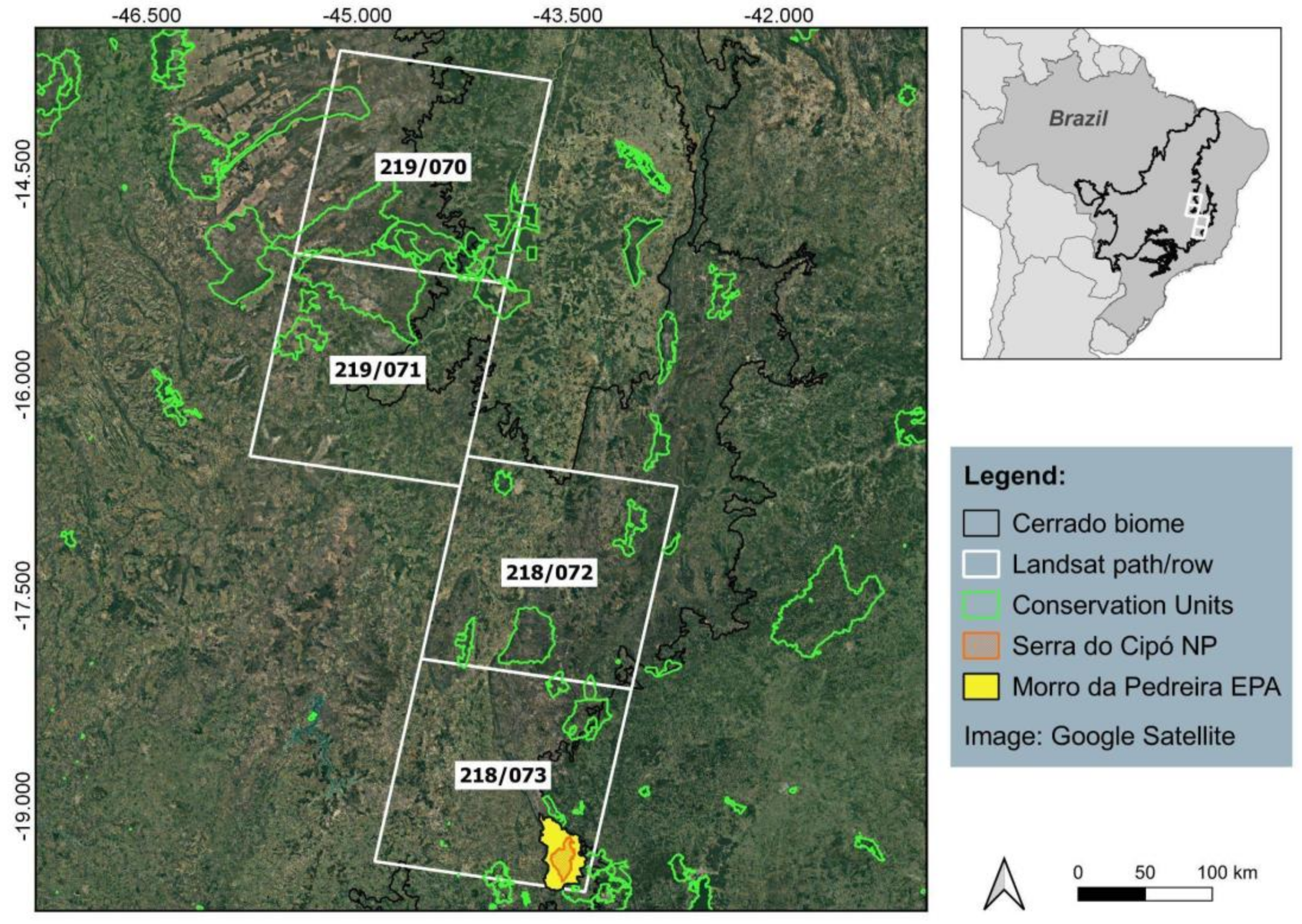
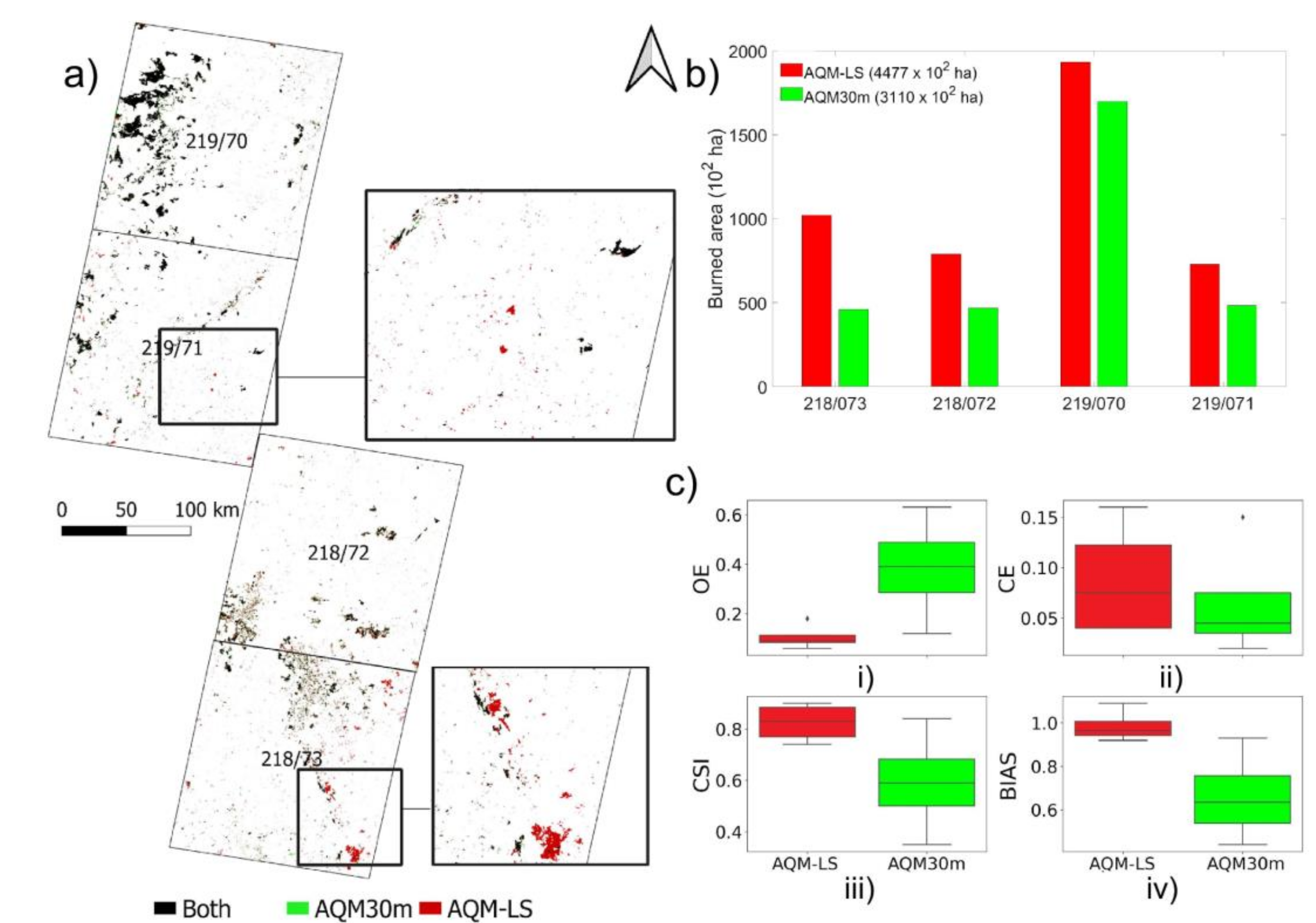
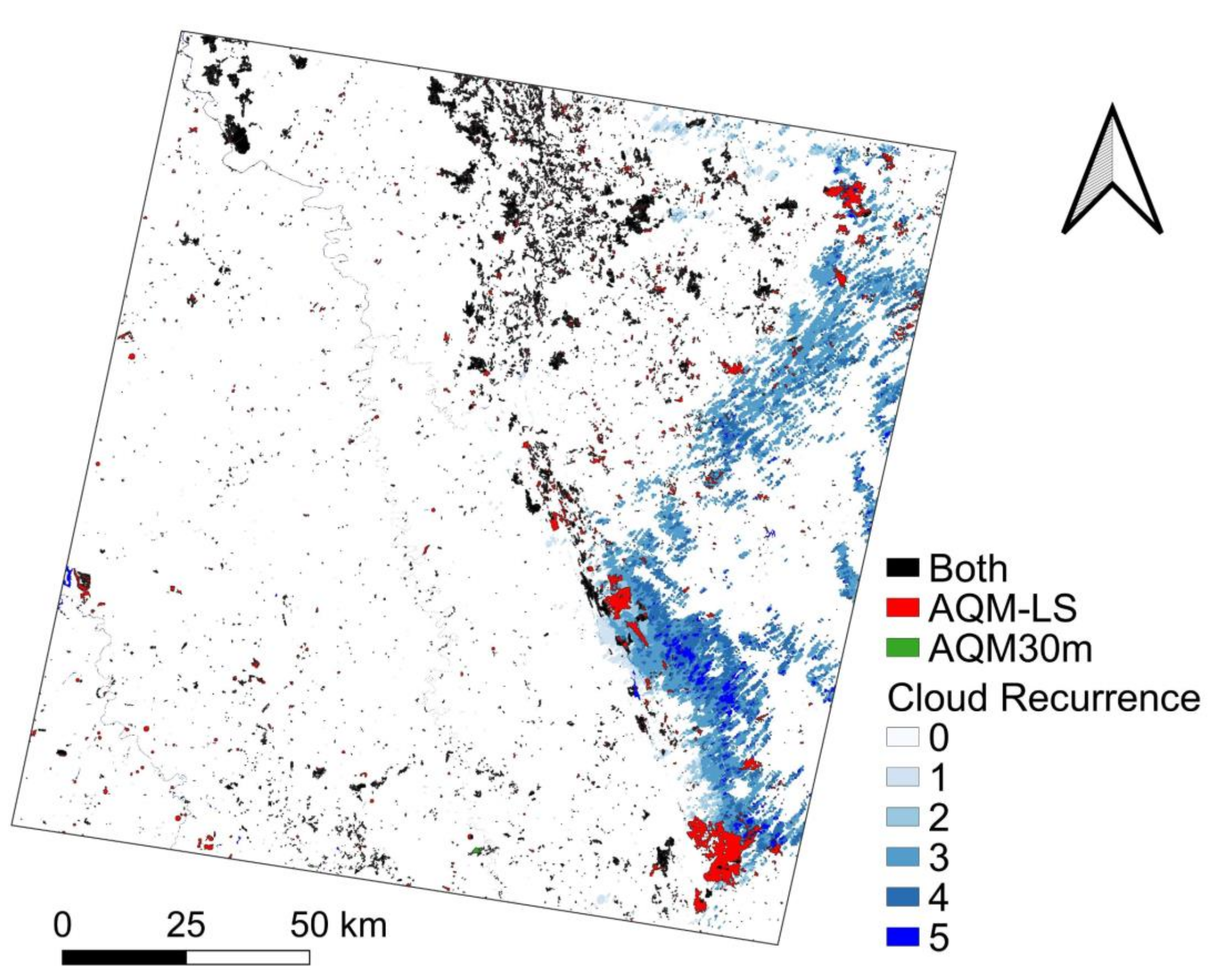


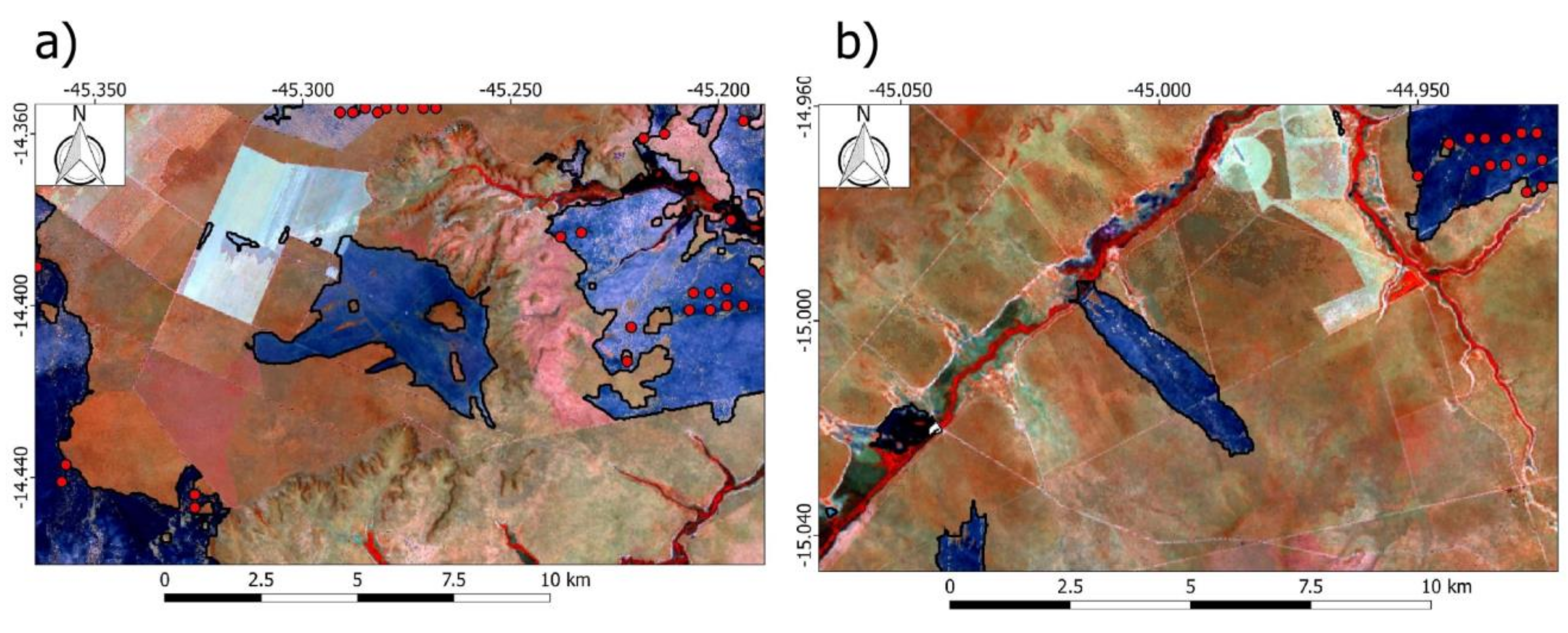
| Landsat Scenes | Dates |
|---|---|
| 218/072–218/073 | 30 July 2015 (T1) 15 August 2015 |
| 31 August 2015 | |
| 16 September 2015 | |
| 02 October 2015 | |
| 03 November 2015 | |
| 219/070–219/071 | 06 August 2015 (T1) |
| 07 September 2015 | |
| 23 September 2015 | |
| 09 October 2015 | |
| 10 November 2015 | |
| 12 December 2015 |
| AQM-PROBA | AQM-VIIRS | AQM-LS | |
|---|---|---|---|
| Reference | [5] | [9] | this work |
| Spatial Resolution (m) | 300 | 375 | 30 |
| Temporal Resolution (days) | 5 | 1 | 16 |
| Channels | NIR (0.84 μm) | NIR (0.86 μm) MIR (3.74 μm) TIR (11.45 μm) | SWIR1 (1.6 μm) SWIR2 (2.1 μm) |
| Satellite Temporal coverage | 2013–2018 | 2012–present | 1985 *–present |
| AF data | VIIRS 375 m | VIIRS 375 m | VIIRS 375 m |
| Spectral index | none | (V,W) [62] | NBR2 [63] |
| Compositing technique | second minimum NIR | minimum W | minimum NBR2 |
| Validation Sample Points | ||||
|---|---|---|---|---|
| Burned | Unburned | |||
| Path/Row | Points | % | Points | % |
| 218/073 | 187 | 3.7 | 4813 | 96.3 |
| 218/072 | 152 | 3.0 | 4848 | 97.0 |
| 219/070 | 327 | 6.5 | 4673 | 93.5 |
| 219/071 | 145 | 2.9 | 4855 | 97.1 |
| Total | 811 | 4.1 | 19,189 | 95.9 |
| Reference | |||
|---|---|---|---|
| Burned | Unburned | ||
| BA Products | Burned | A | B |
| Unburned | C | D |
| Validation Metrics | Acronym | Equation |
|---|---|---|
| Omission Error | OE | C/(A + C) |
| Commission Error | CE | B/(A + B) |
| Bias | BIAS | (A + B)/(A + C) |
| Critical Success Index | CSI | A/(A + B + C) |
Publisher’s Note: MDPI stays neutral with regard to jurisdictional claims in published maps and institutional affiliations. |
© 2021 by the authors. Licensee MDPI, Basel, Switzerland. This article is an open access article distributed under the terms and conditions of the Creative Commons Attribution (CC BY) license (https://creativecommons.org/licenses/by/4.0/).
Share and Cite
Pereira, A.A.; Libonati, R.; Rodrigues, J.A.; Nogueira, J.; Santos, F.L.M.; Oom, D.; Sanches, W.; Alvarado, S.T.; Pereira, J.M.C. Multi-Sensor, Active Fire-Supervised, One-Class Burned Area Mapping in the Brazilian Savanna. Remote Sens. 2021, 13, 4005. https://doi.org/10.3390/rs13194005
Pereira AA, Libonati R, Rodrigues JA, Nogueira J, Santos FLM, Oom D, Sanches W, Alvarado ST, Pereira JMC. Multi-Sensor, Active Fire-Supervised, One-Class Burned Area Mapping in the Brazilian Savanna. Remote Sensing. 2021; 13(19):4005. https://doi.org/10.3390/rs13194005
Chicago/Turabian StylePereira, Allan A., Renata Libonati, Julia A. Rodrigues, Joana Nogueira, Filippe L. M. Santos, Duarte Oom, Waislan Sanches, Swanni T. Alvarado, and José M. C. Pereira. 2021. "Multi-Sensor, Active Fire-Supervised, One-Class Burned Area Mapping in the Brazilian Savanna" Remote Sensing 13, no. 19: 4005. https://doi.org/10.3390/rs13194005
APA StylePereira, A. A., Libonati, R., Rodrigues, J. A., Nogueira, J., Santos, F. L. M., Oom, D., Sanches, W., Alvarado, S. T., & Pereira, J. M. C. (2021). Multi-Sensor, Active Fire-Supervised, One-Class Burned Area Mapping in the Brazilian Savanna. Remote Sensing, 13(19), 4005. https://doi.org/10.3390/rs13194005






